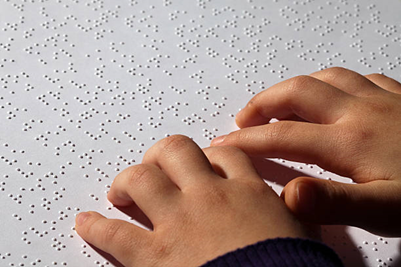Celebrating Accessibility: Happy Birthday Louis Braille
January 2024, by Catherine Gordon
Today is World Braille Day, an International Day of Awareness highlighting the importance of the Braille writing system as a means of communication for blind and visually impaired people worldwide and promoting equal opportunity and inclusion.
It is the birthday of the system’s creator, Louis Braille, who was born in France on this date in 1809. He lost his sight as a child in an accident in his father’s workshop. Inspired at school by a visit from a Captain in Napoleon’s army who taught him about nighttime coding systems, Louis went on to develop and create a fingertip-reading system of raised dots — which became synonymous with his name.
Braille is a code for individual letters or phrases and can be used in different languages. Each character is a cell of up to 6 raised dots, the cell being small enough to feel with the touch of a fingertip, enabling the reader to move quickly from one cell to the next across a page. Versions of Braille for maths symbols and music notation have now also been developed. Braille’s creation is today recognised as a worldwide means of written communication for blind and visually impaired people; it improves quality of life, increases access to education and employment, and reduces social exclusion.
I remember seeing David Blunkett, a government minister between 1997 and 2005, reading speeches written in Braille from the despatch box in parliament, his hands gliding swiftly across the paper in front of him, his guide dog sleeping at his feet. When appearing on the Radio 4 programme ‘Great Lives’, David Blunkett chose to talk about Louis Braille, and the impact his writing system had on his own life chances. He believed it gave him the opportunity to be at the top of his game and lead a full and influential life.
Today there are many other examples of technological developments which improve access and opportunities for a wide array of physically or mentally impaired people. They range from mobility aids, prosthetics and orthotic devices, to hearing aids, screen readers and website apps.
We come across many different companies currently designing new mobility and access products, such as education software tools to improve access for neurodiverse students. There are also specialist funders who back technology developments aimed at people with learning disabilities.
Louis Braille’s lived experience of sight loss informed the creation of his writing system, but how can today’s product developers capture the invaluable feedback of the lived experience of people with a diverse range of disabilities, and interpret what people really want and need?
There is a clear role here for customer insight research to find out what end users really want out of any proposed new product — at the design, prototype testing and product launch stages. Research can also assist the customer journey from purchase and ordering all the way through to product setup, improve the clarity of instruction manuals, and provide ongoing support. Such research can be invaluable for the development of mobility products aimed at end users with diverse and often very person-specific needs.
By engaging with the end user, insight research can give any company a deep level of understanding of their customers’ and prospective customers’ needs and priorities. This will ensure commercial success and also ensure that companies are maximising the social benefit their products bring — inclusion in society and equality of opportunity.
Happy Birthday Louis Braille!
